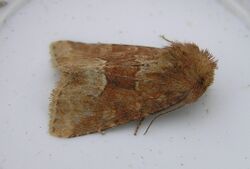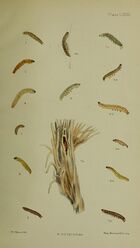Biology:Oligia fasciuncula
| Oligia fasciuncula | |
|---|---|

| |
| Scientific classification | |
| Domain: | Eukaryota |
| Kingdom: | Animalia |
| Phylum: | Arthropoda |
| Class: | Insecta |
| Order: | Lepidoptera |
| Superfamily: | Noctuoidea |
| Family: | Noctuidae |
| Genus: | Oligia |
| Species: | O. fasciuncula
|
| Binomial name | |
| Oligia fasciuncula (Haworth, 1809)
| |
Oligia fasciuncula, the middle-barred minor, is a moth of the family Noctuidae. It is found in Europe.
Technical description and variation
Forewing bright rufous, the median and terminal areas deeper; the inner and outer lines white, especially the outer on inner margin; stigmata slightly paler; hindwing blackish fuscous, the fringe whitish; - ab. cana Stgr. is much paler, especially the basal and outer areas, the colouration more olive drab, without any rufous tint;- pallida Tutt is an extreme form of this, with the median area hoary as well as the basal and outer - suffusa Tutt, from Armagh, Northern Ireland, is greyish black, with all markings faint, somewhat resembling aethiops Haw.; a Scotch form, ab. brunneata is browner, especially the lower half of median area.[Oligia fasciuncula is] recorded [1914 ] only from Western Europe, Britain, Denmark, Holland, N. France, and Spain. This much restricted area of distribution affords a strong reason for not considering this species a form of strigilis.[1]
Biology
The moth flies in one generation from mid-May to late-July. [1].
Larva dull flesh colour; the lines pale greyish ochreous; head and thoracic plate pale brown. The larvae feed in the stems of various grasses, such as tufted hair-grass and Festuca ovina.[2]
Notes
- ^ The flight season refers to Belgium and The Netherlands. This may vary in other parts of the range.
References
- ↑ Seitz, A. Ed., 1914 Die Großschmetterlinge der Erde, Verlag Alfred Kernen, Stuttgart Band 3: Abt. 1, Die Großschmetterlinge des palaearktischen Faunengebietes, Die palaearktischen eulenartigen Nachtfalter, 1914
- ↑ "Robinson, G. S., P. R. Ackery, I. J. Kitching, G. W. Beccaloni & L. M. Hernández, 2010. HOSTS – A Database of the World's Lepidopteran Hostplants. Natural History Museum, London.". http://www.nhm.ac.uk/research-curation/research/projects/hostplants/.
External links
Wikidata ☰ Q1663313 entry
 |


